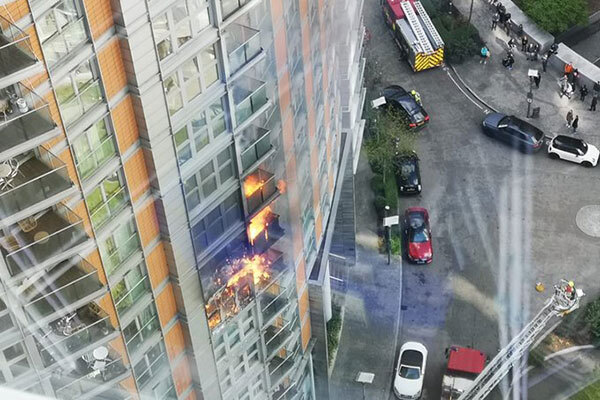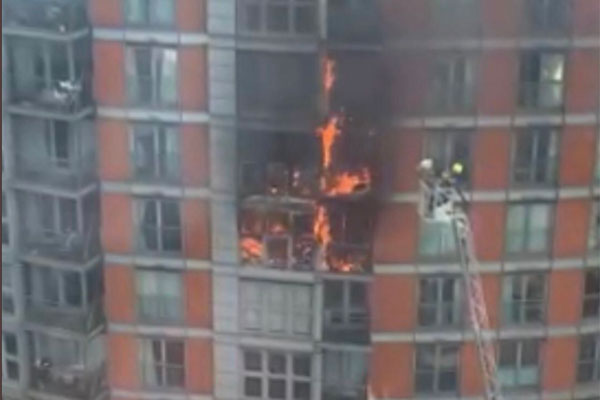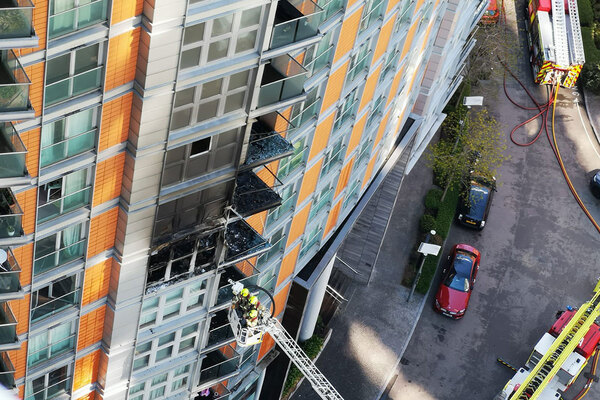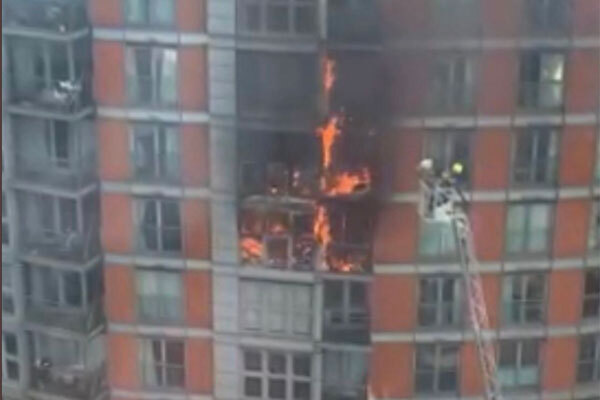You are viewing 1 of your 1 free articles
The New Providence Wharf saga: the block that is yet to have its ACM cladding removed four years after Grenfell
Jack Simpson looks into the story of New Providence Wharf since the Grenfell Tower fire, to try to explain why the development is still covered in aluminium composite material cladding nearly four years after the tragedy
Today saw more than 100 firefighters called to a high-rise block in Poplar, east London, after a fire broke out. The fire at the huge New Providence Wharf development appeared to spread across multiple floors on the building’s facade, and resulted in two people being hospitalised and more than 40 treated at the scene for smoke inhalation and shock.
The source of the fire has yet to be established, and Ballymore has said that the aluminium composite material (ACM) cladding did not combust or contribute to firespread. However, it has brought into light the risks around ACM remaining on high rises. Nearly four years since the Grenfell Tower fire, dangerous ACM cladding remains on dozens of block in England. And in some extreme cases, like New Providence Wharf, work to remove it has not even started yet.
Ballymore has previously told Inside Housing that ACM only covers just under a quarter of New Providence Wharf’s facade, and that the work is more complicated than just removing ACM panels. It has also said that work was imminent, with removal set to start next week.
However, we are now 1,420 days since Grenfell, and well over two years since the government’s £200m private cladding fund was announced. Many private residential blocks have completed removal works, while the majority have at least started work.
In many ways the lack of action at New Providence Wharf encapsulates the struggles and turmoils many leaseholders have faced in getting dangerous cladding removed.
Here is a short timeline of New Providence Wharf and the challenges leaseholders have faced in trying to get their block’s cladding removed.
2001-2005: Construction of the 559-home New Providence Wharf carried out by Ballymore. The development includes several blocks as well as two skyscrapers, Ontario Tower and Providence Tower. Landor Residential, a subsidiary of Ballymore, takes over management and ownership of the block.
June 2017: A devastating fire at Grenfell Tower in west London breaks out, killing 72 people. Concerns about the building’s cladding and how it assisted the spread of fire are raised.
June and July 2017: Government starts programme to check how many residential buildings in England are covered in the same materials. By September, the government finds that 85 of the 89 cladding samples from private blocks fail fire safety tests.
October 2017: The National Fire Chiefs Council publishes guidance recommending that a waking watch is installed in all blocks with dangerous cladding.
December 2017: Despite the government agreeing that this dangerous ACM cladding needed to be removed from high-rise buildings, it said that it was the private sector’s job to “do the right thing” and pay for the cost of removal. Despite these calls from the government, UK property law means that it is unable to force building owners to pay, and the costs will pushed onto leaseholders.
February 2018: Jonathan Evans, chief executive of cladding company Ash and Lacy, writes to housing minister Kit Malthouse claiming that it was nobody’s responsibility other than the government’s to replace dangerous cladding. “These buildings followed the guidance and at the same time failed to meet building regulations [which require the external walls of the building to adequately resist the spread of flame],” Mr Evans wrote. “You must allocate the funds to strip them immediately and reclad within a reasonable timescale.”
October 2018: It emerges that residents face a bill of £2m to remove ACM cladding from their block, with developer Ballymore refusing to cover the bill. In a letter to residents, David Pearson, finance director at Ballymore, said: “You will appreciate that the legal responsibility for costs to replace the cladding depends on the terms of the lease between the building owner and leaseholders.
“The lease in this case indemnifies the freeholder against the costs, given that the financial interest of the building is essentially owned collectively by the leaseholders and little economic value is retained by the freeholder.
“Given the age of the building, the warranty periods have expired so there is no legal recourse to pursue against builder and/or sub-contractor, even if we deemed this appropriate.”
February 2019: After months of wrangling between leaseholders and Ballymore over the costs, the developer issues leaseholders with an ultimatum regarding the £2.4m remediation bill. In a letter sent to residents, it offers as a “goodwill gesture” to cover 20% of the costs and offer an interest-free bridging loan across three years. Ballymore gives residents two weeks to agree, or risk being hit with the full costs. Even with the contribution, leaseholders still face bills of thousands of pounds for the work.
March 2019: A petition signed by 203 people is sent to Tower Hamlets Council and calls on Ballymore to carry out remedial works and cover the costs. The council responds by saying it has met with Ballymore and told it that it “stood ready” to use enforcement powers if sufficient progress was not made. According to the council, Ballymore informed it that it would be issuing a revised offer.
May 2019: Due to the slow speed of remedial work on private blocks with ACM, the government creates a £200m fund to cover work for building owners of private blocks.
September 2019: The £200m private sector cladding fund opens in June and by September more than 80 blocks have applications for funds approved for funding.
March 2020: Coronavirus pandemic begins, and cladding work and construction work stops across the country.
January 2021: Government publishes its first ‘name and shame’ list, highlighting those building owners who have yet to start work to remove ACM from their blocks. Ballymore-owned Landor Residential, the owner of New Providence Wharf, is present on that list.
April 2021: Ballymore responds to a piece by Inside Housing looking into the companies on the ‘named and shamed’ list, explaining why work has taken so long. Ballymore confirms it has secured £8m of government grant funding to go towards cladding removal work.
Ballymore wrote: “We are committed to delivering a safe and comfortable environment for all our residents, which is why we maintain management of our estates even after all the homes are sold.
“Crucially, the work needed to replace the ACM cladding on this building is extremely complicated, much more so than the installation of a new build facade. Our building is horseshoe-shaped, opens directly onto the River Thames, accommodates 559 apartments across five blocks and is fully occupied by more than 1,000 residents.
“To replace elements of a building facade, under this set of circumstances, is an extensive process. We have a project team of many different professional disciplines in place, who have already committed months of focused attention and meticulous work to arrive at both a workable and cost-effective solution.
“This project is well under way and a start on site is anticipated this April.”
Sign up for our fire safety newsletter
Already have an account? Click here to manage your newsletters












